Astrophysics for People in a Hurry
Air Date: Week of May 19, 2017

The Andromeda galaxy is a spiral like our Milky Way, and it’s also the closest major galaxy to our own. (Photo: NASA/JPL-Caltech)
Neil Degrasse Tyson directs New York’s Hayden Planetarium, but he’s also a Pop-Science rock star. Now he’s penned a slim volume titled Astrophysics For People In A Hurry, aiming to make his discipline accessible to non-scientists. He joined Living on Earth Host Steve Curwood for a flash-course on all things celestial, with topics ranging from spagettification by black hole, dark matter and energy, to how the periodic table encompasses, so far as we know, everything in the universe.
Transcript
CURWOOD: If you ask Neil deGrasse Tyson, astrophysics is a lot of fun, even funny at times, but not all of us love physics. Maybe because it uses daunting mathematical formulae, or things we know are dangerous but can’t see, such as x-rays and nuclear radiation. Still, most us do enjoy hearing about the latest NASA probe to fly by a distant planet or seeing the latest pictures from the Hubble telescope or the Mars rover.
So Neil, who is the most popular populist of all things celestial as well as director of New York’s Hayden Planetarium, has written a book that’s perfect for those of us with a shaky understanding of the mysteries and marvels of the universe. It’s called "Astrophysics for People in a Hurry". We haven’t talked recently since he’s been busy with everything from the Cosmos TV series to podcasting, so with his new book we thought we could call him up to get the low-down on things way high up.
Neil deGrasse Tyson, welcome back to Living on Earth.
TYSON: Hey, it’s been a while! You don't call, you don't write you don't...[LAUGHS]
CURWOOD: I know. We'll have to have you back on a more regular fashion here. So, I've got to start by asking you what compelled you to write a book that explains astrophysics in this way. Astrophysics for people in a hurry.
TYSON: Well, I noticed that there were people who were assembling fragmented bits of the universe that they get from the evening news or from a newspaper headline or from some chatter of the water cooler, and there was no mechanism to render these fragments of information coherent. What I did was to create this book, "Astrophysics for People in a Hurry,” on the premise that not everyone has the time to go read a text book or to look at a long video series on television. But you still want to be fluent. You still want to be able to have that conversation about the multi-verse or about the big bang or about Pluto as no longer a planet or colliding black holes or wormholes. You want to be able to still have that conversation. So, this book was written with you in mind.

Astrophysics for People in a Hurry is Neil deGrasse Tyson’s latest book. (Photo: W.W. Norton & Company)
CURWOOD: And I have to say that, if you are in a hurry, it doesn't take that long to get through. It took me maybe a little less than two hours, actually.
TYSON: Oh cool. It took me about three hours. I think I'm a slow reader than you.
CURWOOD: Well, you have to look to see if there are anything that need editing.
TYSON: [LAUGHS]
CURWOOD: I just have to look and say, "Oh yeah," and laugh sometimes. A lot of laughter in this book, here.
TYSON: Well, I think the universe is fundamentally a funny place I would be disingenuous if I described the universe without that hilarity.
CURWOOD: Oh, really? What's the funniest part of about the universe?
TYSON: Just…[LAUGHS]…Well, I think the funniest part is…Well, it's morbidly funny, and I described it in a separate book, a whole other book called "Death by Black Hole". I just think it's kind of hilarious how you would die if you fell into a black hole because you wouldn't just get sort of squashed by the gravity upon landing. En route you get stretched as the tidal forces of gravity pull your feet faster than your head. This is in a feet first dive. So you end up stretching. But not only that, you're getting funneled through the fabric of space and time, so that you end up getting extruded, literally extruded through space like toothpaste through a tube, and you end up diving into the center of the black hole in a long stream of atoms.
CURWOOD: Like a piece of spaghetti, huh?
TYSON: Yeah that’s where you get the word. This is the process of spaghettification.
CURWOOD: [LAUGHS] So, your book begins with the very basics of astrophysics. You march us through from the big bang that got our universe going, and then you get to the point that is not explainable; that is, these forces of gravity that we really have no explanation for except that they're obviously there. You use the title “Dark Matter,” and then you talk about “Dark Energy.” There’s more of that than there is of what we know. So, tell me what we know about what we don't know.
TYSON: No, it's one thing to not know what you're talking about. It's another thing to know that you don't know what you're talking about. These are two separate things. So, in that, it's kind of fun to learn how we came to realize and quantify what it is we don't know. In "Astrophysics for People in a Hurry", two of the dozen chapters are just what you described, one on dark matter and one on dark energy. We have no idea what either of those things are, but we can measure their existence. So we know there's something out there that yields to our measurements but has yet to yield to our creative explanations of what the hell the stuff is. And when you add them together, they comprise 95 percent of all that drives the universe. So, in other words, everything we know and love and all the forces we've measured and understand, and the physics, the chemistry, the biology, the geology, everything is contained within the five percent of the universe that we understand, we can predict, we build courses around it, and the rest is unknown.
CURWOOD: Now, your book discusses the periodic table.
A NASA black hole simulation video.
TYSON: Oh, yeah, I had to put it in there because I love me some periodic table of the elements, and I know it gave some people the shakes because they remember it from high school chemistry, but I just thought it was time to have fun with it, and there's a lot of fun you can have on that table.
CURWOOD: What does it have to do with the evolution of the universe?
TYSON: Well, yeah. So, in this table of 92 elements, plus some extra that we invented, everything in the universe that has material substance is found on this table. Every atom in the universe is there. So, what is Earth made of? It's made of three of these and four of those and five of those and then stir, shake, not stir, whatever. You can reconstruct the universe and then you can ask where these elements come from.
I once asked that of my high school chemistry teacher, and he said, "They come from the Earth," and I said, "OK, but where did they come from before they were in the Earth?" He couldn't answer that question. Well he could, but the answer doesn't come from chemistry. It comes from astrophysics because we learned at mid-century, mid-20th century, where these elements came from. There are forged in the crucibles of high mass, high temperature stars where light elements like hydrogen and helium and carbon combine to become heavier elements, and then that's not good enough because then they’d just be stuck inside the star. What the star then does is, it explodes, scattering its enriched guts across the galaxy, enabling interesting things to form like planets and petunias and people, right? So, the periodic table of elements is an excuse to talk about the formation of the elements in the context of astrophysics and have a little bit of fun along the way.
CURWOOD: That's Neil deGrasse Tyson on his new book, "Astrophysics for People in a Hurry". He'll be back after a break. This is Living on Earth. Stay tuned.
[MUSIC: “ Paul McCartney & Wings, “Venus And Mars” on Venus And Mars, Capitol Records 1975]
ANNOUNCER: Funding for Living on Earth comes from you our listeners, and United Technologies - combining passion for science with engineering to create solutions designed for sustainability in the aerospace, food refrigeration and building industries. UTC companies such as Otis, Carrier, Pratt & Whitney and UTC Aerospace Systems are helping to move the world forward.
This is PRI, Public Radio International.
[CUTAWAY MUSIC: London Symphony Orchestra, “Venus, Bringer of Peace” from “The Planets,” Geoffrey Simon conductor on HOLST: The Planets, composed by Gustav Holst, Philips Records]
CURWOOD: It’s Living on Earth, I’m Steve Curwood. And we’re back now with Neil deGrasse Tyson, talking about his new book, "Astrophysics for People in a Hurry".
So Neil, there's another interesting observation you make. Why are spheres so prevalent in the universe?
TYSON: Oh spheres, I love spheres! There's a chapter in there on being round, and which celebrates the laws of physics as they manifest in the universe, where they give preference to things being round. It's that simple. And, you know, soap bubbles are round, planets are round, stars are round, stars are practically perfect spheres.
Now, here's what happens. If you spin fast, you flatten a little bit. You get a little wider in your belly than pole to pole. So, by looking at how flattened something is, from a sphere, you can then calculate how fast the thing must be rotating.
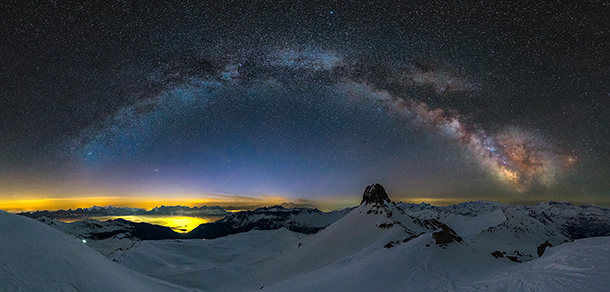
A panoramic view of the Milky Way. (Photo: Lukas Schlagenhauf, Flickr CC BY-ND 2.0)
CURWOOD: So, here's my question. The Milky Way, circular and very flat. What happened?
TYSON: Yes, it's really, really flat. It's flat as a crepe. I would say it's as a flat as a flapjack, but it's even flatter than that. So, here's the Milky Way wanting to be a sphere, but what happens is the gas - I'm talking about the early history - the gas collapses. It sticks to itself like two hot marshmallows at the equatorial plane of its rotation, and so what you get is this gaseous disc. But we have stars scattered above and below the disc that formed before any of that happened. We call that the galactic bulge, and so, yes, you learn about what was left behind in the spherical shape.
So, you get flat galaxies and we have some puffy galaxies, too, because they have less gas where they formed the stars before the gas collapsed, and they stayed in the spherical shapes. So, if you look at the inventory of galaxies in the universe, you know, there's a whole population of them that are spherical, and so our galaxy is about 12 billion years old, something like that, formed shortly after the beginning of the universe. Our solar system formed much later. Our solar system formed late enough for the cloud out of which we collapsed to have contained the enrichment from these high-mass stars that made silicon and nitrogen and oxygen, and all the good things that comprise life. Had Earth formed very early in the solar system, it's likely we would not had enough ingredients to make life as we know it.
CURWOOD: So, speaking of the formation of Earth, we're always excited when there's any news of any other place that could be like Earth - an exoplanet, an exosolar planet, as these guys sometimes call them. Talk to me about the recent ones that we've seen and which ones are most exciting. Which ones, if you could explore, where would you go?
TYSON: Yeah, our catalogs report rising through 3,000 exoplanets, planets orbiting stars not our sun. And what's kind of cool about that is, this whole thing began in 1995. So, recently there's a set of seven planets discovered around a star system called Trappist II, I think it is, and there's seven stars, each of them Earthlike, three of them orbiting the famous Goldilocks Zone. You want to orbit too close to your host star because if you have liquid water there it would evaporate and too far away it would freeze. Life as we know it on Earth thrives in liquid water, so if you're looking for life as we know it, you're going to look for life in the Goldilocks Zone. So this has three planets out of those seven orbiting in the Goldilocks Zone. So this made headlines justifiably.
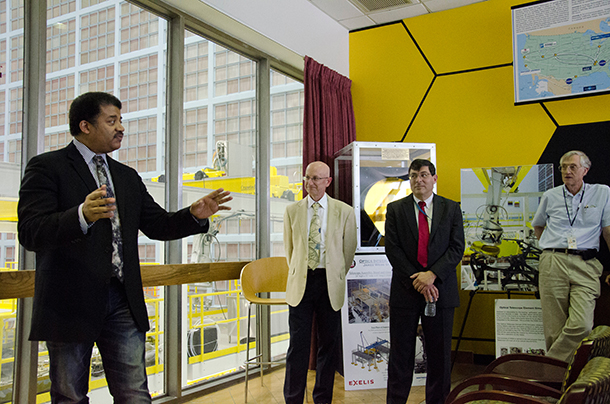
Neil deGrasse Tyson speaking on a visit with Goddard's Space Flight Center Director Chris Scolese and the James Webb Space Telescope team. (Photo: NASA Goddard Spaceflight Center, Flickr CC BY 2.0)
But I want to caution that while there are Earth-sized planets, I wouldn't call them Earthlike planets because how long does it take Earth to orbit our sun? Tell me.
CURWOOD: It takes roughly a year. That's what call “a year.”
TYSON: Thank you. 365 and a little bit of days, OK. You know how many days it takes these planets to orbit? Six days, eight days to go around their host star. It's a very different dynamical system.
CURWOOD: Huh. Where in the universe does look like Earth?
TYSON: We've got a few. So, of the 3,000 exoplanets, I forgot the number, a couple hundred maybe, are Earthlike planets around a Goldilocks Zone orbiting a sunlike star. That's the difference. The Trappist star system is not a sun-like star. It's a much cooler star. Much much cooler. That's why the planets have to orbit close in to get the Goldilocks Zone happening for them.
CURWOOD: Speaking of Earthlike places, where in the 'hood, where nearby in our solar system are there some moons that might be attractive for Earth-type activities?
TYSON: We're pretty sure there's no other sign of intelligent life in our solar system. Some would argue there's no intelligent life on Earth. But in our solar system there are half a dozen places that are tantalizing for the possible thriving of microbial life, possibly deep under the soils of Mars, where we know there is water down there. Is there a place that keeps it warm? Radioactive decay is a source of heat. We know some elements stay radioactive for long times. Could there be aquifers, liquid underground puddles of water where microbes are just thriving?
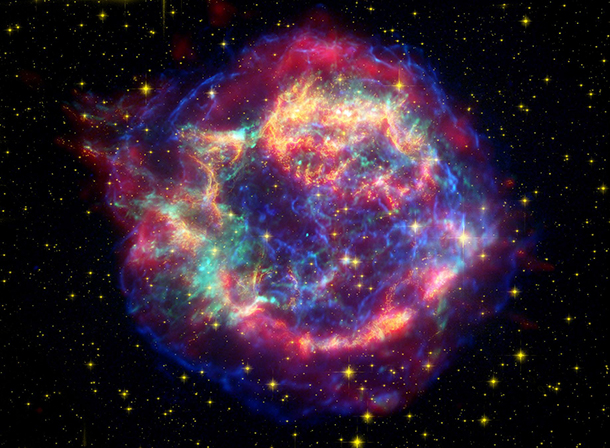
Supernova Cassiopeia A. Life as we know it is possible in part because some stars explode spectacularly at the end of their life, and these supernovae incubate as well as disperse throughout the universe the heavier elements necessary to life. (Photo: NASA/JPL-Caltech/STScI/CXC/SAO)
There’s Jupiter's moon Europa, well, out of the Goldilocks Zone, but it is kept warm through these stress forces induced by Jupiter and other surrounding moons. So, this place is, on its surface, solid ice, but the heat from Jupiter is getting pumped in deep within the center, and we are nearly certain that this ice is afloat atop of an ocean of liquid water that's been liquid for billions of years. So, I joke about this. I want to go ice fishing on Europa, go cut a hole through the ice, put down a submersible, see if anything swims up to the camera lens and licks it. Then you're good.
CURWOOD: So, in writing "Astrophysics for People in a Hurry", you demonstrate your ability to explain things in terms that average people can grasp and even enjoy and have fun. So, what's your process for doing that with a complex target?
TYSON: Yeah, thanks for that question. If I come to the table equipped with a utility belt of pop culture references, and you come to the table with your pop culture references, of course, you have the same references as I do. That's why it's called pop culture. OK? Now, you might be a different subset of pop culture, tbut hat's my duty to then learn what that is. OK? So, you come for the pop culture and you stay for the science, and this is not dumbing it down. I don't think I've ever been accused of dumbing down science. It's simply finding other interesting ways to think about science, and I'll give an example.
I'm watching a football game. I was channel surfing. I had 15 minutes until a movie I wanted to watch, and I came upon a football game that in that moment went into overtime.
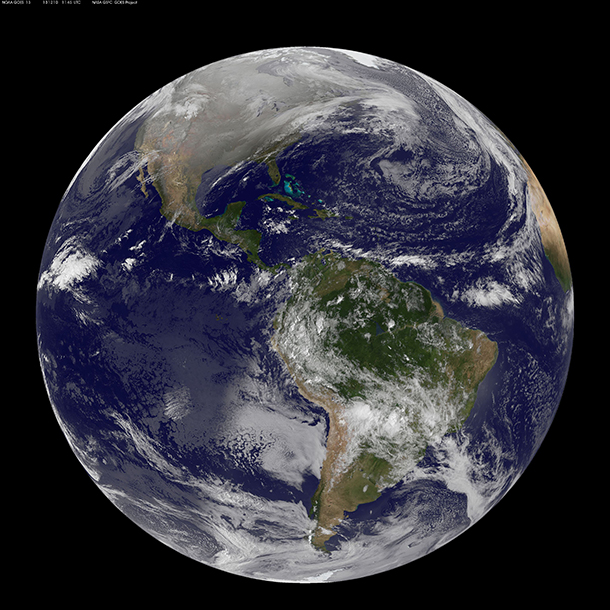
A view of planet Earth. (Photo: NOAA/NASA GOES Project)
CURWOOD: Uh-oh.
TYSON: And, sure enough, one team got possession of the ball, and then they kicked a 50-some-odd yard field goal. And I'm looking at it, and the ball tumbles, and then it goes and it hits the left upright and then careens through for the win. And I said, "Wait a minute", and I checked the orientation of the stadium. I looked at how far the ball was kicked, and then I tweeted. I said, "The winning kick..." - I think it was the Cincinati Bengals - "was aided by a third of an inch shift to the right due to the rotation of the Earth".
CURWOOD: [LAUGHS]
TYSON: Oh my God. It blew people's minds!And it was, like, “Oh my gosh, the Earth helped!” And then, people got all, “God helped the Cincinati Bengals win the game”. And I didn't have to explain to you what a field goal was or what football is or what a left upright is. That's the common language of pop culture. And now I add something to it. You know, you're going to be interested in that. You know it because it's kind of weird and it's fun to know, even if you're on the losing end of that three point goal.
So that’s an example. And I found that when you do that people want more.
CURWOOD: So, by the way, in what ways if any has the current political climate impacted how you communicate science these days?
TYSON: Yeah, you know, stuff just got real, right, in the last several months? So, it's one thing to say whatever you want as a politician running for office, but if you then attain office and then enact it, then…Because politicians will say anything to get elected by and large, so you can pander but then reality has to set in when you want to pass an actual law, and it's important that laws, to the extent that science matters to them, that they're based on actual science.
I don't know when you'll air this, but we are in the time of the science march on Washington scheduled to coincide with Earth Day, and many scientists are coming out for this, just to show importance of the role and value of science in enlightened governance.
By the way, Abraham Lincoln, in 1863, when he clearly had more important things on his plate, in that year signed into law the National Academy of Sciences which then and now is charged with…It's an independent party of research scientists who are charged with advising the government on all ways science matters to policy. Abraham Lincoln was a Republican, by the way, in case people forgot. So, you go through the years of presidents and you find these major moments where agencies were established to exploit the role that science can and should play in our health, our wealth, and our security. If you turn around and say, "I don't like the science, and therefore I'm going to ignore it", oh my God, I don't know what country that is. What country is that? But what I do know is the country that comes out of that will be sliding backwards, not walking or running forwards.
CURWOOD: We've pretty much stopped space exploration in a big way. We’re doing stuff at the margins, but your book, "Astrophysics for People in a Hurry," really looks at creation of the universe and the basics of physics. It raises lots of questions that would really demand that we look further away from our planet, and it's been a while since we devoted resources to that, a lot of resources.
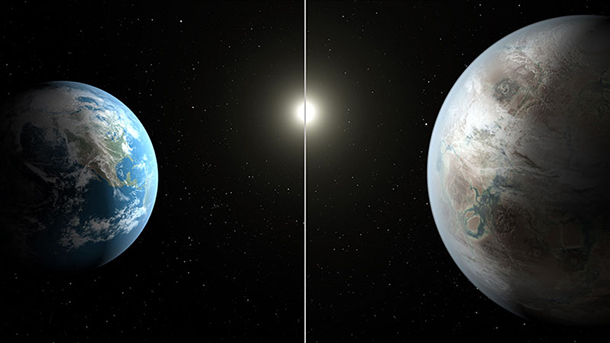
An artistic rendering of Kepler-452b, the first near-Earth size exoplanet to be discovered. (Photo: NASA/Ames/JPL-Caltech/T. Pyle)
TYSON: Well, yeah, so we are sending space probes, and never at the rate that we always want because we're sort of greedy astrophysicists. But we have probe around Saturn right now. This is last year. There is a probe if you remember that passed Pluto and found another target in the outer solar system. So, it's not like we're not out there. What our dreams were for so many of us was that we would have colonies on Mars, and there would be a human presence. And what has happened over the years is, with the miniaturization of electronics and the development of robotics, a lot of the scientific discoveries you might make by sending a human are done better by sending a robot. So, I get that. Fine.
But the flipside of that is nobody's ever held a ticker tape parade for a robot. Nobody's ever asked a robot to write their life story about what it was for being in space. There's something cultural, something very human, about what it is to touch someone who has been on the frontier of exploration and discovery.
So, you're right, we're not quite there and I'm disappointed. So, something else needs to happen to infuse this kind of dream state in the public, and by the way, because you have very well-read smart listeners to your show, surely a subset of them are saying, “We've got problems on Earth. Why are we spending money in space?” Surely, there's a subset who are thinking that, I can feel it.
CURWOOD: I have to agree.
TYSON: You're out there. I know you're out there. So, here's the point. Consider that Mars once had liquid running water, and it's bone-dry today on its surface. Something bad happened on Mars. We don't know what yet. Mars is to our right. Venus to our left is 900 degrees Fahrenheit. It has a runaway greenhouse effect. Venus is almost exactly the same size and gravity as Earth is. In fact, we called it our sister planet until we got close and said, “Oh, you're 900 degrees. There's nothing sister about you”. So, something bad happened on those planets. I want to know what because I don't want that to happen to Earth. And if you're going to say, “Let's only study Earth and solve our problems here, then look outside”, that's like saying, “We're all huddled in a cave”. And I say, “Gee, I wonder what is on the other side of that mountain”. “No, we can’t look on the other side, we've got to solve the cave problems first. Don't leave the cave”. You realize that's what it looks like to anyone who's in the business of exploring when you say, “Do not explore”.
CURWOOD: There might be one way I could summarize your book, "Astrophysics for People in a Hurry," that, a remark you made a while back, that in many respects, that it's all the same.
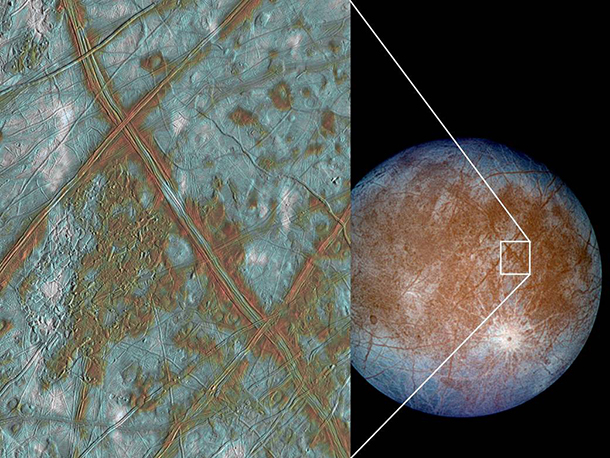
Jupiter's moon Europa has a crust that’s blocks of solid ice, but likely contains liquid water beneath – which means that it could contain microbial life. (Photo: NASA/JPL/University of Arizona)
TYSON: Yeah. One of the most profound discoveries of science is that the laws of nature that we measure here on Earth are the same that exist on the moon, in the sun, across the galaxy, across the universe itself. And that is a remarkable fact when you think about it because here we are on this Earth, this speck called Earth. There's not…Is it written in the sky that says Earth must be the same as everywhere else? If it were not, then science would be a very local affair. Here we would develop all our science just to apply to Earth. If you go to another planet, you’d have to like reinvent other kinds of science and other kinds of laws of physics and chemistry and biology, just to account for what's there. That would be really inefficient but we would do it if we had to. The fact that what we discover here on Earth applies everywhere means we don't have to. I look at the signature of atoms and molecules on Earth, and I find it using spectra, and I find those very same signatures in stars halfway across the universe.
There's not going to be some other planet where Newton's laws somehow don't work. We've measured them to work everywhere, so that sameness, not only in the laws of physics but in the ingredients of the universe, the very atoms that comprise your body, came from a star that gave it's life billions of years ago. We are connected in a fundamental way, and that connectivity for me makes the universe bearable in its infinitude. So many people say, “I feel small in the scale of the universe”. Fine, we are small. Get over it. But because we're the same as the universe, it gives us a deep sense of belonging and participation in this great, unfolding, cosmic story. That's how I and any of my astrophysics colleagues think about this universe.
Neil fuses pop culture and science to connect with his audience.
Today's @Bengals winning OT field goal was likely enabled by a 1/3-in deflection to the right, caused by Earth’s Rotation.
— Neil deGrasse Tyson (@neiltyson) October 11, 2015
CURWOOD: Neil directs the Hayden Planetarium at the American Museum of Natural History in New York. Neil, thanks so much for taking the time today.
TYSON: Yeah, thanks for having me. Always good to be on your show. You know, maybe one day, you can change the name of your show to be Living on Mars.
CURWOOD: [LAUGHS]
Links
Astrophysics for People in a Hurry
NASA is on a “Journey to Mars”, planning to send humans to Mars in the 2030s
Living on Earth wants to hear from you!
Living on Earth
62 Calef Highway, Suite 212
Lee, NH 03861
Telephone: 617-287-4121
E-mail: comments@loe.org
Newsletter [Click here]
Donate to Living on Earth!
Living on Earth is an independent media program and relies entirely on contributions from listeners and institutions supporting public service. Please donate now to preserve an independent environmental voice.
NewsletterLiving on Earth offers a weekly delivery of the show's rundown to your mailbox. Sign up for our newsletter today!
 Sailors For The Sea: Be the change you want to sea.
Sailors For The Sea: Be the change you want to sea.
 The Grantham Foundation for the Protection of the Environment: Committed to protecting and improving the health of the global environment.
The Grantham Foundation for the Protection of the Environment: Committed to protecting and improving the health of the global environment.
 Contribute to Living on Earth and receive, as our gift to you, an archival print of one of Mark Seth Lender's extraordinary wildlife photographs. Follow the link to see Mark's current collection of photographs.
Contribute to Living on Earth and receive, as our gift to you, an archival print of one of Mark Seth Lender's extraordinary wildlife photographs. Follow the link to see Mark's current collection of photographs.
 Buy a signed copy of Mark Seth Lender's book Smeagull the Seagull & support Living on Earth
Buy a signed copy of Mark Seth Lender's book Smeagull the Seagull & support Living on Earth

